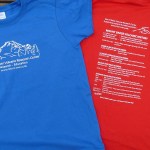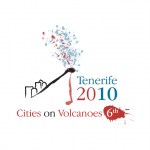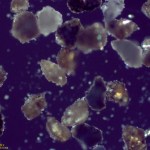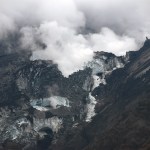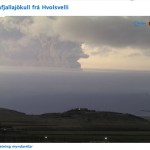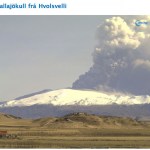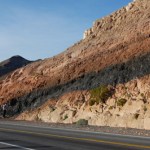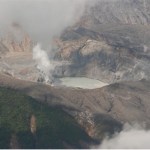Volcano Research
The crater lake at Eyjafjallajökull as seen on June 11, 2010. Image from the Icelandic Met Office by Sveinn Brynjólfsson.
After keeping us transfixed for almost two months this spring, Eyjafjallajökull has slowly drifted from the headlines. However, this doesn't mean that interesting things - volcanologically-speaking - have stopped happening at the Icelandic volcano. For one, a crater lake has now been spotted at the summit vent of the volcano. This lake is steaming vigorous, but at the end of last week, the Icelandic Meteorological Office and the Institute of Earth Sciences declared that…
Last year I mentioned the fundraiser for the excellent Mt. Baker Volcano Research Center - and lo and behold, I will mention it again. The new 2010 t-shirts are out and you can purchase one to support one of the best volcano research sites on the web (and off the web) - with a plethora of information on Mt. Baker, updates on the research going on at the volcano and any news of activity from Washington's northern-most volcano.
2010 MBVRC t-shirt. Click to enlarge image.
This year's t-shirt features Mt. Baker's eruptive history (see above) and can be yours by visiting the MBVRC blog site. You…
Looking for some volcano news - you've found it.
A shot of volcano "tourists" near the erupting Pacaya. Photo by the Associated Press.
Eruptions reader Dr. Boris Behncke dropped a note that Kilauea has not one but two active lava lakes right now. The lava lakes can be seen on the webcams for the Halema`uma`u Crater and the Pu`u O`o flank vent. The latest status update from June 6th by the USGS Hawaiian Volcano Observatory talks about both the summit and rift activity (video) on Kilauea as well. Meanwhile, Hawaii 24/7 has a piece in the Volcano Watch series about whether residents of Maui need…
The NASA Earth Observatory has been dazzling us with images from the Eyjafjallajökull eruption for months - but they have been dazzling us with volcanoes images for years! Here are two more images for those of you who love seeing volcanoes from above:
Cleveland, Alaska
As I mentioned earlier this week, Cleveland volcano likely had a small eruption over the weekend producing a small ash cloud. Cleveland is already known as an extremely picturesque volcano, both from the ground for its highly conical shape - a textbook andesitic stratocone - and from space. This new June 1 image is from almost…
This week is the Cities on Volcanoes conference - now in its sixth iteration. This year the conference is in Tenerife in the Canary Islands and while I wish I could be there, I'm not. However, we can all live vicariously through Dr. David Calvo, who will be sending daily updates from the meeting. He's been busy with the usual first day activities of someone helping run a meeting, but here is his first blurb from Tenerife:
CitiesonVolcanoes6 started just today at Puerto de la Cruz (Tenerife, Spain), and right now more than 700 people are sharing their knowledge about volcanism and volcanic…
The ash plume from Eyjafjallajökull, piercing the cloud deck above the volcano. Image courtesy of the Icelandic Met Office, taken on May 13, 2010. See the latest report on the eruption.
With all the rapid fire news on eruptions as of late, combined with my busy schedule during the school year, I haven't been able to post as many articles on some basic aspects of volcanology. I will try to remedy some of this over the summer and the first will look at volcanic ash and specifically the ash from Eyjafjallajökull. I've taken some photomicrographs of the ash from Eyjafjallajökull (sent to me…
News, news, news!
Ash from Eyjafjallajökull piling up on a roof at Seljavellir. Image courtesy of the IMO, by Ari Tryggvason.
The latest from Eyjafjallajökull has the volcano continuing to puff away - producing intermittent airspace closures over Europe. The Icelandic Met Office reports a ~7 km (21,000 foot) ash plume, but they note that the explosivity of the eruption seems to have waned some since a maximum on May 13. Right now, the IMO estimates the eruption rate at ~200 tonnes/second. Lets put that in a little perspective - a Ford F-150 pickup weighs about 2 tonnes, so the volcano is…
Some news for a sleepy Monday:
Mt. Hood in Oregon.
The ash from Eyjafjallajökull is, once again, causing significant airspace closure over northern Europe - close of 1,000 flights today. However, much of the closures are fairly short-lived, but that isn't keeping people happy. The eruption hasn't actually changed much, just that the winds are bringing ash towards Europe. The ash for the next few days will likely effect the England, Scotland, Ireland, Netherlands, France and possibly other parts of northern Europe (along with airspace over Greenland and the north Atlantic). The ash plume is…
The GÃgjökull outlet glacier on Eyjafjallajökull, showing the steaming lava flow carving its way through the glacier. Image taken May 5, 2010 by Dr. Joseph Licciardi.
A quick update on the ongoing activity at Eyjafjallajökull:
The activity at the volcano continues to be more explosive during the last few days than it was in the previous week, leading to more potential for airspace closures over Europe if the winds were to shift. Currently, the VAAC ash advisory only seems to suggest that even Spain may get a taste of the ash sometime tomorrow, but most of Europe will be OK. However,…
Grading grading grading!
A webcam capture of the eruptive plume from Eyjafjallajökull on the morning of May 6, 2010.
News:
A quick update on the Eyjafjallajökull eruption: The volcano has been producing an impressive ash plume over the last day (see image above). The current ash plume is reaching 5.8-6 km height (19-20,000 ft) - and causing some trouble over Ireland and Scotland. However, much of airspace closed yesterday has reopened (for now). You can see two new images of the ash plume over at the NASA Earth Observatory. As for the continued fallout from the ash plume from April, British…
Mt. Saint Helens erupting in 2004.
I had a chance to watch a new NOVA special that airs May 5 (PBS) on the 1980-1986 and 2004-2008 eruption cycles at Mt. Saint Helens, along with the recovery of the blast zone from the 1980 eruption. It is a fitting episode as we approach the 30th anniversary of the eruption that took out the north side of the volcano and devastated a vast swath of Cascade wilderness in Washington on May 18, 1980. Many of you have already sent me your Mt. Saint Helens memories (keep them coming!) for my tribute to the eruption, but if you want to get started on remembering…
A night shot of the Eyjafjallajökull eruption showing the glowing plume from the strombolian explosions and the Aurora Borealis overhead.
A quick update on the current activity at Eyjafjallajökull eruption: the eruption continues at the summit craters, but there seems to be less ash being erupted, at least yesterday. The latest update from the Icelandic Met Office suggest that things are settling down - but floods are still periodically being produced by melting of the glacier:
Volcanic tremor has been similar the last 24 hours. GPS stations around Eyjafjallajökull showed deflation…
Webcam shot of Eyjafjallajökull erupting on April 17, 2010.
I don't want to get too far into this but there has been a lot of chatter about the link between melting ice caps and increase/decrease/neither of volcanism. The two main articles we're talking about are:
Scientific American, saying that ice loss could increase volcanism:Ice cap thaw may awaken Icelandic volcanoes
The long and short of the Scientific American study is that you reduce the pressure of rocks in the crust/mantle below Iceland, you generate more melting - depressurization melting of rock. If you melt the ice cap, you…
Lots to do!
Tourists flock to the Eyjafjallajökull-Fimmvörduháls in Iceland.
The media does love the term "supervolcano", and a number of Eruptions readers sent me a link to the article on the dreaded submarine "supervolcanoes". I would delve into this article from Live Science, but it sadly again does a dreadful job with a lot of this - remember, "supervolcano" is a made-up word by the BBC with no strict definition, so trying to say there are a dozen supervolcanoes worldwide is just silly. And why does it take multiple paragraphs and multiple mentions of "scientists" before they get a…
Idunn Mons on Venus with recent emissivity data from the Venus Express overlaid on the topography, suggesting recent lava flows.
NASA released images today that suggest that the surface of Venus has experienced some relatively recent volcanic events (geologically speaking). By examining the surface in infrared, the Venus Express, launched by the European Space Agency (ESA) has found that three spots on the surface exhibit signs of recent volcanism. The long-and-short of the research lead by Dr. Sue Smrekar of JPL is that a number of Venutian lava flows (shown above on Idunn Mons) show less…
Actually, no the volcanoes aren't from space, but pictures of the volcanoes were taken from space. The NASA Earth Observatory has posted three more gems of volcanic activity taken by one of the fleet of earth imagers in orbit:
A recent image of Chaiten taken by EO-1. Image courtesy of the NASA Earth Observatory.
There is a great image of the busy Kamchatkan Peninsula, where four volcanoes are seen erupting in a single image - Kliuchevskoi, Bezymianny, Shiveluch and Karymsky. The plume from Karymsky is especially prominent as a grey streak above the white snow of the Russian winter (albeit it…
Map showing the location of submarine volcano Marsili, near the Italian coast. Image from INGV.
The subject of submarine volcanism near Italy has come up before here on Eruptions but now it has made the jump into the worldwide media after some claims made by Enzo Boschi, president of the National Institute of Geophysics and Volcanology (INGV).
The long and short of what I can tell from the articles is that Marsili, a submarine volcano in the Tyrrhenian Sea, could be a threat to create a significant tsunami that would hit Italy (amongst other Mediterranean countries). The volcano lies only 150…
I'm still playing catch-up after my week in the desert, so I've seen a lot of articles I've wanted to mention ... but a certain other volcano has taken up a lot of my time. However, I will attempt to make amends for that now.
By the way, would you believe Ubehebe Crater was closed? How do they close a volcano, anyway? However, I did get a great snap of a welded tuff on the road outside of Shoshone, CA.
A strongly welded tuff near Shoshone, CA. The dark interior is remelted volcanic ash/tephra surrounded by less welded pink tuff with abundant pumice clasts. Denison student David Sisak is on…
Mt. Baker in the northern Cascades of Washington.
One of the best websites dedicated to any volcano is the Mt. Baker Volcano Research Center - hosted by Western Washington University. I've talked about it before, but David Tucker and his associates have put together an excellent resource on this (at least in my opinion) woefully underappreciated Cascade volcano.
There is a pile of news from the MBVRC and I thought I'd pass it along.
First off, the 2010 T-shirt design contest has kicked off. Last year the MBVRC raised much needed funds with a T-shirt sale and now you can try to design the…
Some news for a busy Tuesday:
The crater at Poas volcano in Costa Rica, taken February 25, 2010. Image courtesy of OVSICORI by Federico Chavarria.
After the MSNBC debacle, it is nice to see some good articles on why the Chilean earthquake was overall less disastrous than the Haitian earthquake, why the tsunami wasn't as large as predicted and why these earthquakes are not abnormal. There are a lot of factors involved - the location, depth, preparedness, wealth - so the comparison can be very telling in terms of both geologic and societal issues.
The other scientific fallout from the Chilean…
